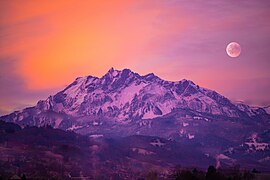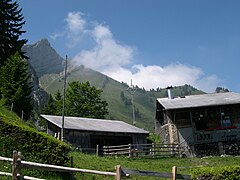Pilatus (mountain)
Mountain in Switzerland From Wikipedia, the free encyclopedia
Pilatus, also often referred to as Mount Pilatus, is a mountain massif overlooking Lucerne in Central Switzerland. It is composed of several peaks, of which the highest (2,128.5 m [6,983 ft]) is named Tomlishorn.
| Pilatus | |
|---|---|
 Pilatus above Lake Lucerne | |
| Highest point | |
| Peak | Tomlishorn |
| Elevation | 2,128.5 m (6,983 ft) |
| Prominence | 585 m (1,919 ft)[1] |
| Parent peak | Brienzer Rothorn |
| Isolation | 16.7 km (10.4 mi)[2] |
| Coordinates | 46°58′26″N 8°14′28″E |
| Naming | |
| Language of name | German |
| Geography | |
| Country | Switzerland |
| Cantons | |
| Parent range | Emmental Alps |
| Topo map | Swiss Federal Office of Topography swisstopo |
| Climbing | |
| First ascent | 14th century |
| Easiest route | Pilatus Railway (world's steepest cogwheel railway) |
Geography and transport
Summarize
Perspective

The whole mountain range stretches at least from the Lopper just opposite from Stansstad to the east as far as at least to the Mittaggüpfi (1,917 m [6,289 ft]) and the Risetestock (1,759 m [5,771 ft]) to the west on the border between LU and OW.
The highest peak, Tomlishorn (2,128.5 m [6,983 ft]), and the other peaks, such as Widderfeld (2,076 m [6,811 ft]) even further west than the Tomlishorn on the border between LU and OW, Matthorn (2,040 m [6,690 ft]) to the south, the Klimsenhorn (1,906 m [6,253 ft]) to the north (NW), and Rosegg (1,974 m [6,476 ft]) and Windegg (1,673 m [5,489 ft]) to the east, both on the border of NW and OW, should only be approached with appropriate Alpine hiking equipment.
Jurisdiction over the massif is divided between the cantons of Obwalden (OW), Nidwalden (NW), and Lucerne (LU). The main peaks are right on the border between Obwalden and Nidwalden.
The top can be reached with the Pilatus Railway, the world's steepest cogwheel railway, from Alpnachstad, operating from May to November (depending on snow conditions) and the whole year with the aerial panorama gondolas and aerial cableways from Kriens. Tomlishorn is located about 1.3 km (0.81 mi) to the southeast of the top cable car and cog railway station. Two other peaks, closer to the stations are called Esel (Donkey, 2,118 m [6,949 ft]), which lies just east over the railway station, the one on the west side is called Oberhaupt (Head-Leader, 2,105 m [6,906 ft]).
During the summer, the "Golden Round Trip" — a popular route for tourists — involves taking a boat from Lucerne across Lake Lucerne to Alpnachstad, going up on the cogwheel railway, coming down on the aerial cableways and panorama gondolas, and taking a trolleybus back to Lucerne.
History
A few different local legends about the origin of the name exist. One claims that Pilatus was named so because Pontius Pilate was buried there.[3] However, a similar legend is told of Monte Vettore in Italy. Another is that the mountain looks like the belly of a large man, Pilate, lying on his back and was thus named for him. The name may also be derived from "pileatus", meaning "cloud-topped."
Numbered amongst those who have reached its summit are Conrad Gessner, Theodore Roosevelt, Arthur Schopenhauer (1804), Queen Victoria and Julia Ward Howe (1867).
The cog railway opened in 1889. That same year, Leonardo Torres Quevedo presented his innovative cable car project for public transport,[4][5] but it was dismissed by the country's authorities.[6]
The mountain has fortified radar (part of the Swiss FLORAKO system) and weather stations on the Oberhaupt summit, not open to the public view and used all year round.
Gallery
- Pilatus mountain seen from Gisikon Root
- Panoramic view towards Mythen
- A view of the Hotel and Restaurant, the cog railway top station, and the Esel peak in the back
- Cable car descending
- Ibex family near summit
- A view from the cog-wheel railway
- Chapel on Pilatus
- Cableway
- Paraglider taking off from summit
- Pilatus seen from Stanserhorn funicular
- Pilatus with the Alpnachersee below seen from Stanserhorn
Climate
| Climate data for Pilatus, elevation 2,105 m (6,906 ft), (1991–2020) | |||||||||||||
|---|---|---|---|---|---|---|---|---|---|---|---|---|---|
| Month | Jan | Feb | Mar | Apr | May | Jun | Jul | Aug | Sep | Oct | Nov | Dec | Year |
| Mean daily maximum °C (°F) | −0.8 (30.6) |
−1.2 (29.8) |
0.6 (33.1) |
3.2 (37.8) |
7.1 (44.8) |
10.5 (50.9) |
12.6 (54.7) |
12.8 (55.0) |
9.6 (49.3) |
7.3 (45.1) |
2.7 (36.9) |
0.1 (32.2) |
5.4 (41.7) |
| Daily mean °C (°F) | −3.8 (25.2) |
−4.4 (24.1) |
−2.5 (27.5) |
0.1 (32.2) |
4.0 (39.2) |
7.5 (45.5) |
9.5 (49.1) |
9.8 (49.6) |
6.5 (43.7) |
4.0 (39.2) |
−0.3 (31.5) |
−2.9 (26.8) |
2.3 (36.1) |
| Mean daily minimum °C (°F) | −6.5 (20.3) |
−7.1 (19.2) |
−5.2 (22.6) |
−2.5 (27.5) |
1.3 (34.3) |
4.8 (40.6) |
6.8 (44.2) |
7.2 (45.0) |
4.0 (39.2) |
1.4 (34.5) |
−3.0 (26.6) |
−5.6 (21.9) |
−0.4 (31.3) |
| Average precipitation mm (inches) | 164.3 (6.47) |
154.6 (6.09) |
149.8 (5.90) |
163.4 (6.43) |
152.8 (6.02) |
167.9 (6.61) |
163.3 (6.43) |
161.1 (6.34) |
110.5 (4.35) |
98.5 (3.88) |
131.7 (5.19) |
173.0 (6.81) |
1,790.9 (70.51) |
| Average precipitation days (≥ 1.0 mm) | 12.2 | 11.3 | 13.3 | 12.8 | 14.6 | 15.2 | 14.4 | 13.9 | 11.3 | 11.0 | 11.5 | 13.7 | 155.2 |
| Average relative humidity (%) | 64 | 66 | 72 | 77 | 82 | 84 | 83 | 81 | 79 | 71 | 68 | 65 | 74 |
| Mean monthly sunshine hours | 123.5 | 131.6 | 154.9 | 156.0 | 152.1 | 146.4 | 161.8 | 164.9 | 153.9 | 158.9 | 116.2 | 106.0 | 1,726.2 |
| Percentage possible sunshine | 51 | 50 | 45 | 41 | 35 | 33 | 36 | 40 | 44 | 52 | 48 | 47 | 42 |
| Source 1: NOAA[7] | |||||||||||||
| Source 2: MeteoSwiss[8] | |||||||||||||
In literature
In The Chalet School Does It Again. (1955) Elinor Brent-Dyer retells the Pilate burial place legend.
Mount Pilatus plays a pivotal role in the conclusion of Brad Thor's fiction novel Lions of Lucerne.
See also
References
External links
Wikiwand - on
Seamless Wikipedia browsing. On steroids.













